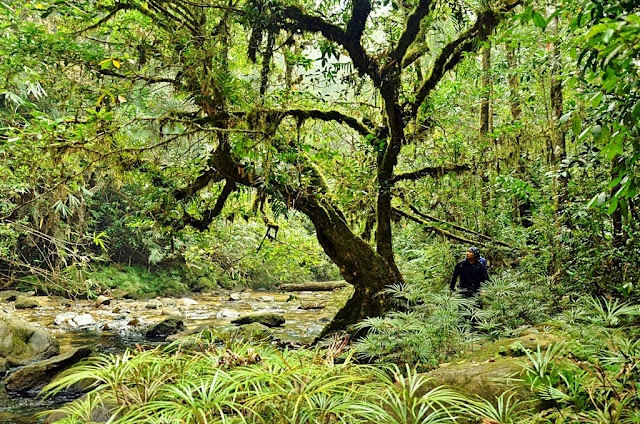
Rainforests
Rainforest are forests characterized by high rainfall, with definitions setting minimum normal annual rainfall between 1750–2000 mm (68-78 inches). The monsoon trough, alternately known as the intertropical convergence zone, plays a significant role in creating Earth's tropical rainforests. There are two types of rainforest, tropical rainforest and temperate rainforest. Malaysia located near equator are blessed with tropical rainforest.
40 to 75% of all species on the world's habitats are indigenous to the rainforests. It has been estimated that many millions of species of plants, insects, and microorganisms are still undiscovered. Tropical rainforests have been called the "jewels of the Earth", and the "world's largest pharmacy", because over one quarter of natural medicines have been discovered there. Tropical rainforest are well known for its medicinal plants and herbs. Rainforest are also responsible for 28% of the world's oxygen turn over, often misunderstood as oxygen production, processing it through photosynthesis from carbon dioxide and storing it as carbon through biosequestration.
There is misconception that to walk through rainforest is easy in believing that the undergrowth in a rainforest which is restricted in many areas by the lack of sunlight at ground level makes it possible to walk through, not like walking in the park though. Characther of forest floor or shrub layer not only determine by level of sunlight going through the canopy but also the type of soil. Granite soil would make it possible for a clear forest floor. Eventhough with a minimun amount of sunlight there would be vines plants tangle from forest floor struggle to rise to the highest canopy. Forest floor composition of dense, tangled growth of vines, shrubs, and small trees called a jungle is determine by level of sunlight passing through the canopy .
 |
| A hiker on Tropical Rainforest Trail beside a Small Stream. Click here for higher resolution photo |
Tropical Rainforest
A tropical Rainforest is a biome found within (roughly) 10 degrees north or south of the equator. They are common in Asia,Australia, Africa, South America, Central America, Mexico and on many of the Pacific Islands. Within the World Wildlife Fund'sbiome classification, tropical rainforests are considered a type of tropical wet forest (or tropical moist broadleaf forest) and may also be referred to as lowland equatorial evergreen rainforest. Minimum normal annual rainfall between 1,750 millimetres (69 in) and 2,000 millimetres (79 in) occurs in this climate region. Mean monthly temperatures exceed 18 °C (64 °F) during all months of the year.
For temperate rain forests of North America, Alaback's definition is widely recognized:
- Annual precipitation over 1400 mm
- Mean annual temperature between 4 and 12 degrees Celsius. (39 and 54 degrees Fahrenheit)
However, required annual precipitation depends on factors such as distribution of rainfall over the year, temperatures over the year and fog presence, and definitions in other countries differ considerably. For example, Australian definitions are ecological-structural rather than climatic:
Plant in temperate rainforest are all predominantly coniferous, sometimes with an understory of broadleaved trees and shrubs. The conifer dominance is a consequence of two climatic factors: Although the region has high total precipitation, most occurs during the winter, and summers are relatively dry. During summer, moisture stress reduces the amount of photosynthesis possible especially for broadleaved trees. However, winters are very mild, and coniferous species are capable to carry on substantial amounts of their yearly photosynthesis during fall, winter and spring.
I would focus more on tropical rainforest as this is the kind of rainforest that involved and what I meant in all of my mountaineering endeavoring and bushing around.
Layer of tropical rainforest
A tropical rainforest is typically divided into four main layers, each with different plants and animals adapted for life in that particular area: forest floor / shrub layers , understory, canopy, and the emergent. Only the emergent layer is unique to tropical rainforests, while the others are also found in temperate rainforests. While plant in temperate rainforest are all predominantly coniferous, tropical rainforest are blessed with diverse plant species.
The emergent layer contains a small number of very large trees which grow above the canopy layer, reaching heights of 45-55 m, although on occasion a few species will grow up to 70 m or 80 m tall. Such species of emergent layer is Tualang tree.
The canopy is the primary layer of the forest and forms a roof over the two remaining layers. Most canopy trees have smooth, oval leaves that come to a point. It's a maze of leaves and branches. Many animals live in this area since food is abundant.
Little sunshine reaches the understory layer, so the plants have to grow larger leaves to obtain sufficient sunlight. The plants in this area seldom grow to 12 feet. There is a large concentration of insects here.
The shrub layer and forest floor will be dimmer than other layer. Few plants grow in this area, as a result. Since hardly any sun reaches the forest floor things begin to decay quickly.
All this layers can only be found on lowland Rainforest, as the contour change with increasing height the type canopy and layering also differ.
Related Articles
Malaysia Peat Swamp Forest
The Lost World of Maliau Basin
Unique of Malaysia Elephant





No comments:
Post a Comment
From this point onward anonymous comment will be deleted, please use your google account, or at least pun on your name and your url...
thanks for your comment